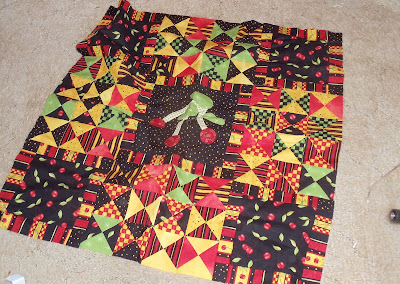I'm back! I'm finally feeling a great deal better, although I have a feeling this cough will hang around a few days and I'm still a little stuffed up--but nothing like the way I felt last week. And best of all, I've finally done something interesting! (At least I thought it was!)
Remember my company's mystery event this year when we ended up making beer? This is the brewmaster, Robert, who the firm hired to teach us:
Robert also teaches cheesemaking, which seemed really cool too, and I came back from the event talking about taking a cheesemaking class someday. I don't remember if I told you, but for Christmas, the Wild Child presented me with gift certificates for three of us to take the class, and that's what she, my sister-in-law, Kathy, and I did today.
Robert has an old Victorian house and the bottom floor--at least what we saw of it--is his office and kitchen classroom. I took some photos during class and I'll tell you a little bit about what we did.
First, cheesemaking--at least what we did today--mostly involves mixing milk with "stuff" to change the milk into curds and whey. The whey is separated out and the curds become cheese. The whole process seems kind of magical although it's really just chemistry!
Here we had a couple pots of what would become cheese going on the stove. The pot on the left contained the beginnings of feta cheese while the pots on the right would become mozzarella. (Sort of.)
Here's just a photo of part of the kitchen--you can see the empty gallon containers of milk and empty smaller containers of goat's milk (for the goat cheese we also made). And yes, there's some cheese and crackers on the counter--a sample of what we may be able to make someday if we keep up our studies!
One of the steps in making cheese is hanging the curds in cheese cloth to let the whey continue to separate out. The cheese in these cheesecloth bundles is feta.
Robert doesn't usually include mozzarella in his beginning cheese class but I asked if he could show us how to make it. Seriously, I think it's probably the simplest soft cheese that I'd actually use fairly often. As it turns out, mozzarella requires more work--you have to keep heating it and kneeding it as you would bread (if you didn't just go buy bread at the grocery store).
The reason I say we sort of made mozzarella is that for some reason, of the two batches of mozzarella cheese we made, neither turned out. Robert, of course, has made mozzarella cheese numerous times and has never had it fail this way, but for some reason, this time it did. The problem was that at some point, when the mozzarella reaches the correct temperature through heating and kneeding, it kind of melds together and forms a ball--a little like bread will--and ours just never did.
There in the center is some mozzarella Robert made a week or two ago, and on the left is one of our batches--which looks kind of lumpy, as you can see. We understand it will taste okay and will melt, but the consistency isn't right. (Toward the back, on the right, is that great cheese Robert made and let us taste.)
Finally, here's our cheese, resting at home. The feta is still hanging in cheesecloth in a big canning pot on top of the refrigerator, and the goat cheese is curdling in the canning jars until tomorrow when it will be transferred to cheesecloth--after the feta comes out. And that sad mozzarella is in the refrigerator--I think I might cut it into large cubes and marinade it but maybe not; I haven't decided yet.
One thing's for sure though. It's going to be a long time before we run out of cheese. But when we do? I just ordered a home cheesemaking book Robert recommended. I may need to start a new blog. How does Kim's Big Cheesemaking Adventure sound?











































